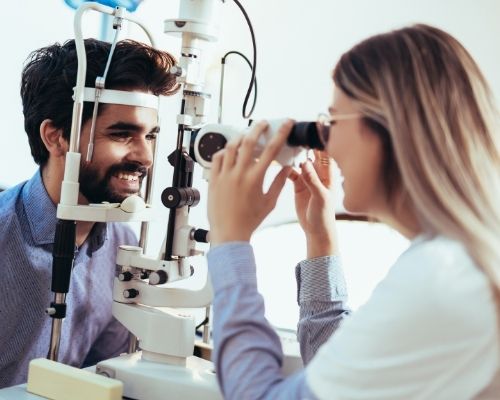
Healthy Vision Month is a time to raise awareness about the importance of having healthy vision. Berkeley Eye Center would like to take this time to encourage everyone to educate themselves about the importance of healthy vision and the ways we can protect our vision health.
The Importance of Vision Health
Why is vision health so important? Here are some eye-opening facts to consider, courtesy of the Centers for Disease Control (CDC):
- Vision loss is one of the leading causes of disability in the United States.
- Approximately 12 million people 40 years and over in the United States have some form of vision impairment.
- An estimated 93 million adults in the United States are at high risk for serious vision loss — but only half have visited an eye doctor in the past 12 months.
- People with vision loss are more likely to suffer from depression, diabetes, hearing impairment, stroke, falls, cognitive decline, and premature death.
- The National Institute for Occupational Safety and Health (NIOSH) reports that nearly 2,000 U.S. workers sustain job-related eye injuries that require medical treatment every day.
- The annual economic impact of major vision problems among the adult population 40 years and older is more than $145 billion.
- As the population of older people continues to accelerate, the number of people experiencing vision loss will continue to increase.
Steps You Can Take to Keep Your Vision Healthy
Fortunately, many vision problems can be successfully treated and controlled, provided they are diagnosed in their early stages. Regular eye exams and maintaining a sight-healthy lifestyle are the keys to protecting your vision health.
Maintain a Vision Healthy Lifestyle
Maintaining a healthy lifestyle is equally important to maintaining and preserving our healthy vision. A vision healthy lifestyle includes:
- Maintain a healthy lifestyle. Watch your weight, get regular exercise, don’t smoke, and eat a diet rich in eye healthy proteins (eggs, cold water fish), fruits (oranges and other citrus fruits), vegetables (kale, carrots) and nuts (almonds, sunflower seeds) to protect your vision and your overall health.
- Know your family history. Since many eye conditions are hereditary, knowing your family history can help you determine if you’re at risk.
- Wear protective eyewear. The right safety eyewear can prevent injuries on the job, around the house, or while playing sports. Make sure the protective eye wear is appropriate for the task.
- Wear sunglasses all year. The Sun’s ultraviolet rays are just as bad for your eyes as they are for your skin. Sunglasses that block out 99 to 100% of both UVA and UVB radiation shut out the glare and protect eyes from the sun’s ultraviolet rays. Sunglasses should be worn year round — not just to protect your eyes while you’re at the beach in summer, but also in winter to protect your eyes while you’re up on the slopes.
Get A Regular Eye Exam
Many serious eye diseases — such as macular degeneration, cataracts, and glaucoma — develop slowly over time. A lot of people don’t realize they have a problem until they begin to experience vision loss or impairment. A comprehensive eye examination can spot potential sight and vision problems in their earliest stages when treatment is most effective.
Some of the assessments performed during an eye exam include:
- Dilated exam – The doctor will use eye drops to dilate, or widen, your pupils. The widened pupil allows your eye doctor to get a look inside your eye to determine if there are any problems.
- Distance vision test – Uses the familiar Snellen Acuity Chart to measure your basic visual acuity and diagnose refractive errors.
- Eye movement test – The eye doctor observes your eye movements as you follow a small light that passes from one side of the eye to the other to evaluate any problems in the extraocular muscles.
- Eye pressure – The doctor will check your eye pressure to determine if you are at risk for glaucoma. If the pressure is abnormal, additional tests may be needed to assess your risk for glaucoma.
- Refraction test – The refraction test checks your sight using various lenses. After the test, the eye doctor can provide an accurate prescription for corrective lenses, if needed.
- Slit-Lamp examination – A slit lamp is used to evaluate the overall health of the eye, providing a magnified view of your eye so the doctor can inspect the inside and outside areas of the eye.
- Color Blindness Test – Uses cards with dot patterns of different colors to determine if an individual suffers from color blindness.
In addition to vision-related problems, an eye exam can also reveal early symptoms of other serious health conditions such as diabetes, high blood pressure, cancer, and heart disease.
Get the Most Out of Life With Healthy Vision
When was the last time you had a comprehensive eye exam? There’s no better way to celebrate Vision Healthy Month than with a visit to Berkeley Eye Center. We’ve been caring for the vision health of Houstonians for over 60 years. With locations all over Houston and surrounding communities like Atascocita, Bay City, Katy, Kingwood, The Woodlands, Clear Lake, Sugar Land, Huntsville, and Cleveland there’s sure to be a Berkeley Eye Center near you.
